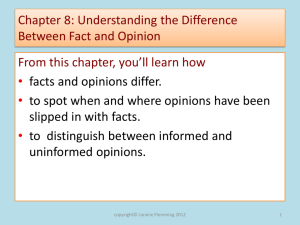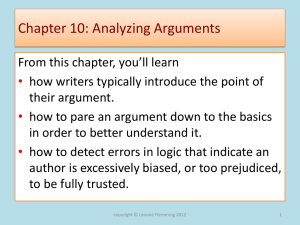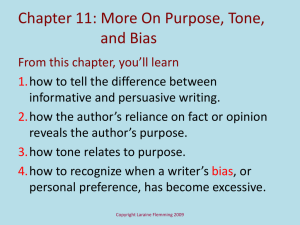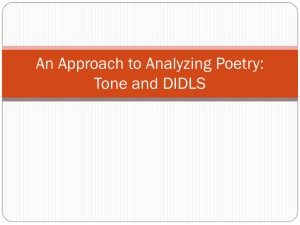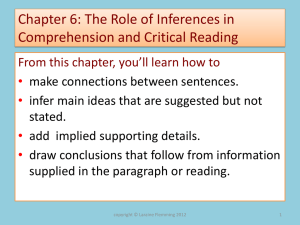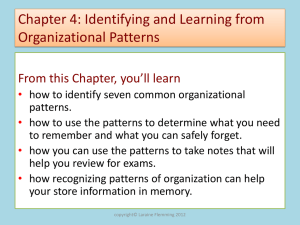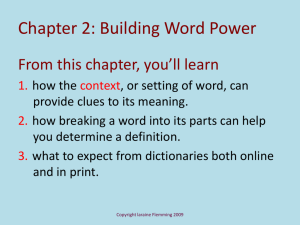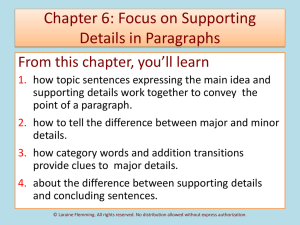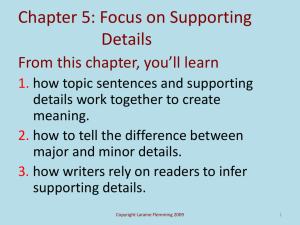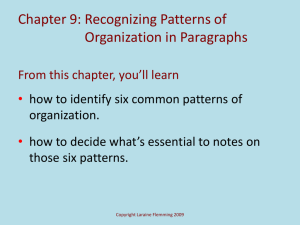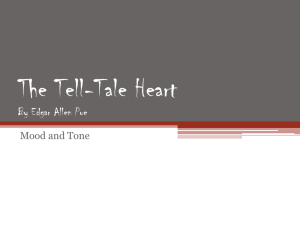Chapter 9: Focusing More On Purpose and Tone
advertisement
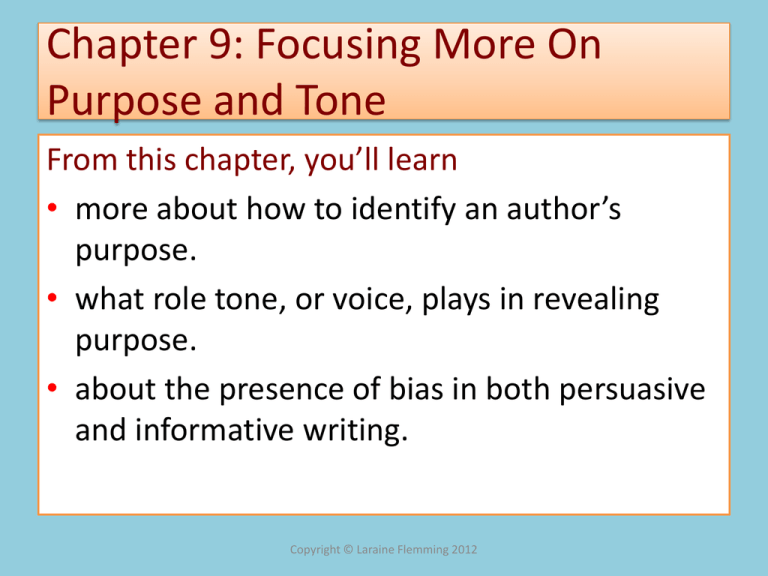
Chapter 9: Focusing More On Purpose and Tone From this chapter, you’ll learn • more about how to identify an author’s purpose. • what role tone, or voice, plays in revealing purpose. • about the presence of bias in both persuasive and informative writing. Copyright © Laraine Flemming 2012 Informative Writing • doesn’t attempt to convince readers to share a specific opinion. • describes or explains ideas without evaluating them. • makes it clear that opinions expressed belong to people other than the author. • expresses both sides of an argument with equal force. • relies on language that produces little or no emotional impact on reader. Copyright © Laraine Flemming 2012 Informative Writing (continued) • appears mainly in reference works, newspaper articles, journals, and educational web sites. • relies on factual language rather than colorful images. • makes no personal references to the author or to the audience. • likely to include information expressed in numbers. • avoids using words that tell readers how to interpret events, e.g. fortunately, more important, impossible as it may seem. Copyright © Laraine Flemming 2012 Example of Informative Writing Sleep researcher Robert Stickgold says that rapid-eye movement, or REM, sleep is essential to memory consolidation. In other words, it is during REM that new information is analyzed, categorized, and stored in long-term memory. In support of his theory, Stickgold cites numerous studies in which researchers teach subjects a new task and then break the subjects into two different groups: (1) subjects who get tested later the same day and (2) subjects who get re-tested after a night’s sleep. Based on his research, Stickgold maintains that subjects who sleep after learning consistently perform better than those who got no sleep. Copyright © Laraine Flemming 2012 Persuasive Writing • tries to convince readers to share or at least consider a specific point of view. • expresses competing points of view with the intention of showing that one opinion or perspective is better than another. • explicitly or implicitly reveals the author’s point of view. • usually employs emotionally charged language. • uses words and phrases meant to guide the reader’s interpretation, e.g. thankfully, surprisingly, fortunately. Copyright © Laraine Flemming 2012 Persuasive Writing (continued) • appears in editorials, reviews, books, and web sites promoting a theory or person. • makes use of strong imagery designed to sway emotions. • often includes personal pronouns that refer to the author and/or the audience. • features a tone, or voice, that betrays an attitude or emotion. Copyright © Laraine Flemming 2012 Example of Persuasive Writing • Sleep researcher Robert Stickgold has solved the mystery of rapid-eye movement, or REM, sleep, which has long been a puzzle. REM has been a mystery because the brain waves recorded by electroencephalographs during this stage of the sleep cycle suggest a highly active state of mind, similar to the state of being awake. Stickgold, however, has solved the mystery, and his research shows that during REM, new learning is analyzed, categorized, and stored in memory. In other words, it’s during REM sleep that memory consolidation takes place. While Stickgold’s theory still has its critics, the majority of those engaged in sleep research believe he has figured out why brain activity during REM sleep is so intense: It’s because the sleeping brain is busy working. Copyright © Laraine Flemming 2012 Recognizing the Primary Purpose When thinking about purpose, keep in mind that 1. the purpose sometimes changes as the reading develops. 2. a persuasive piece of writing can open with a purely informative introduction but then move steadily in the direction of persuasion. 3. if informative writing turns persuasive, the primary, or main, purpose is almost always persuasion. 4. it’s less likely for a writer to open with a persuasive passage and then turn strictly informative. Copyright © Laraine Flemming 2012 Spot Quiz: What’s the primary purpose of the following reading? • Dwight D. (Ike) Eisenhower, the 34th President of the United States, was born in Denison, Texas in 1890. He was the first professional soldier elected to office since Ulysses S. Grant and the first president to preside over 50 states. Eisenhower’s public image was that of a conservative thinker, who believed deeply in the rights of the states to govern themselves. But the real “Ike” was a good deal more devious and less conservative than the public knew. People were profoundly shocked when Eisenhower called in the national guard to protect black students trying to enter an all-white high school in Little Rock, Arkansas. Conservatives didn’t interfere with states rights. Eisenhower, however, was never really a conservative. As he himself expressed it in a 1951 letter kept secret for years, he had always had “liberal sympathies.” He just kept them hidden. Copyright © Laraine Flemming 2012 Definition: Tone • Like the tone of a person’s voice, tone in writing refers is the attitude, emotion, or feeling a writer conveys to the reader. Depending on the subject under discussion, writers can use any number of different tones. A few of many possibilities: • furious • neutral • bullying Copyright © Laraine Flemming 2012 • sympathetic • comical • skeptical How Writers Choose a Tone Writers choose a tone based on • purpose, i.e., informative or persuasive. • context, e.g., for a reference book or a weekly magazine. • audience, e.g. is the audience likely to be receptive or unreceptive to the ideas expressed? Copyright © Laraine Flemming 2012 The Verbal Devices that Create Tone Writers create tone through any one or all of the following: • word choice • sentence length e.g.. a succession of short sentences can create a chatty, conversational tone. • grammar, i.e., formal or conversational • references to the audience or self • selection of details • imagery and figurative language, e.g. While his ex-wife got on with her life, he wrapped depression around him like a warm blanket and spent his days moping. Copyright © Laraine Flemming 2012 Tone and the Reader Recognizing tone is important because • it helps readers identify the writer’s purpose. • it allows readers to control how much tone affects their response. • it offers a solid clue to the writer’s degree of bias, i.e., the more emotional the tone, the greater the bias or favoritism expressed toward one position or another. What tone do you hear in the following excerpt? Copyright © Laraine Flemming 2012 Listening for Tone: What Tone does the Writer Use in the Following Passage? Birds of America • The new year did not bring good news for thousands of birds flying the skies above the little town of Beebe, Arkansas. Just before midnight on New Year’s Eve, around 2000 birds dropped to the ground dead from what researchers are now calling severe trauma. Although ornithologist Karen Rowe claimed that such incidents are not unusual, most Americans would be hard put to come up with a memory of a similar event: Arkansas residents woke up to find their lawns and pathways littered with bird corpses. While spokespeople for the Arkansas Game and Fish Commission tried to calm the population by saying that such incidents occur in the aftermath of hail storms or fireworks, a general air of mystery prevailed because no one could adequately explain why the birds had died since blackbirds do not generally fly at night in the first place. • What would you say the purpose is? Copyright © Laraine Flemming 2012 Listening for Tone: NowWhat Do You Hear in this Passage? More Mysterious Bird Deaths • Three days after thousands of birds died in Arkansas on the first day of 2011, a similar event happened in Louisiana, where state biologists spent January 3rd picking up the bodies of birds and shipping them off to be analyzed. It will take several weeks before the lab results on the birds become public. In the aftermath of the event, State Wildlife Veterinarian Jim LaCour pointed out that starvation and cold fronts have caused “massive” bird deaths before, but never in quite the same numbers. According to Paul Slota, a spokesperson for the U.S. Geological Survey’s National Wildlife Center, the U.S.G.S’s record show that there have been 16 similar events involving blackbirds in the past 30 years with as many as 1,000 blackbirds dying simultaneously. (Source of quotations: theadvocate.com, WBRZ, Louisiana Broadcasting LLC) • And what would you say the purpose is? Copyright © Laraine Flemming 2012 A Word to the Wise on Tone and Bias The more strongly you can “hear” a tone in the author’s writing, the more likely it is that the author also has a bias, a leaning in favor of one side or another. Copyright © Laraine Flemming 2012 A Word to the Wise A Word to Identifying the author’s tone can help you determine the author’s degree of bias, but as you will see in Chapter 9, bias is reflected in more than just the author’s choice of tone. It’s also revealed in the author’s choice of detail and for that matter, in what the author chooses to leave unsaid. Copyright © Laraine Flemming 2012 An Example of Bias that Depends on What’s Left Unsaid The author of this excerpt seems to be offering a fair and unbiased evaluation of a common claim—that public schools used to do a better job than they do now. Critics who claim that our public schools are no longer doing their job effectively do have proof for their claims. The scores on the Scholastic Assessment Test (SAT) have declined by more than 10 percent over the last half century. That’s a hard fact to argue against. And then again maybe it’s not so hard to argue with. Copyright © Laraine Flemming 2012 What’s Been Left Out Often Counts for a Lot! The author is correct. SAT scores in reading and math have declined. But here’s what’s missing: Today the SAT is taken annually by roughly two million students with very different degrees of preparation. When it was first administered, it was taken by only around 10,000 students. And as one writer expressed it, this was a “largely self-selected group seeking admission to elite private colleges.” In other words, they had been preparing for the test for most of their lives. (Quotation is from “Dreams of Better Schools” by Andrew Delbanco. The New York Review of Books) Given the differences in the make up and size of the test populations, pointing out score increases or decreases doesn’t prove much. So perhaps the author is more biased than you might think at first glance once you know what’s been left out of her argument. Or perhaps she just doesn’t know about the test’s origins. Either way, what’s missing makes all the difference. Copyright © Laraine Flemming 2012 Bias and Textbooks Although you might assume that textbooks never have a bias, think again. Textbook authors may try and control their bias and let readers draw their own conclusions, but they too can reveal a personal point of view or a bias for or against a particular position. Pages 558-559 of Chapter 9 will give you some examples of textbook authors that differ on how they interpret the same facts. Copyright © Laraine Flemming 2012 Final Wrap: Focusing More on Purpose and Tone 1. In a piece of informative writing, which one of the following would the author not do? a) b) c) d) e) describe an issue or topic without evaluating it avoid any personal references use a friendly, engaging tone attribute the opinions expressed to other people describe both sides of an argument with equal force Copyright © Laraine Flemming 2012 Final Wrap: Focusing More on Purpose and Tone 2. In a piece of persuasive writing, which one of the following is the author very likely to do? a.) use a cool, informal tone b.) explain both sides of an issue with equal force. c.) address the audience personally with the pronoun “you.” d.) rely heavily on statistics e.) avoid emotionally charged language Copyright © Laraine Flemming 2012 Final Wrap: Focusing More on Purpose and Tone 3. What would you say is the tone of the following reading? • Ever since it was identified in the 1980s, victims of chronic fatigue syndrome have been treated with something close to contempt. It was generally assumed that the disorder they complained of was imaginary, a reflection of unresolved psychological conflict. In other words, it was all in their head. Thankfully new research has put an end to this insulting attitude and two different medical studies have connected the disease to the presence of a specific virus. As a result, an advisory panel for the Food and Drug Administration has suggested that blood donations from people with the disease—now that it’s actually acknowledged as such—not be accepted. The F.D.A. is not required to accept the recommendation of the panel, but at least this is a sign that Chronic Fatigue Syndrome, which has caused so many people so much agony, will not be treated as an imaginary ailment. It’s about time. (Source of information:http:www.nytimes.com/2011/01/04 David Tuller, “Exhausted by Illness.”) What made you choose the tone and what do you think is the author’s purpose? Copyright © Laraine Flemming 2012 Final Wrap: Focusing More on Purpose and Tone 4. How would you label the tone and purpose of this reading? • Having recently written an e-book, now available on line, I find that I have to rethink a slogan I once passionately espoused : “The Internet is Free.” While that slogan certainly applied to the idea of censoring the Internet, it was also meant to be taken literally, and I once believed that everything available on the Internet should be given away, not sold. What I’m infinitely more aware of these days, is how much work goes into those applications, programs, and widgets I used to download without a second thought. When I charge for an e-book, I’m charging for the enormous amount of time and knowledge that went into creating what I will, without shame, call my product. I’m also asking you the consumer to pay for something you save when you buy my e-book, and that’s time. I can show you how to do efficient file management in about the two and a half hours it takes to read my book. Can you figure it out for yourself over the course of several months? Absolutely, but would you want to spend all that time on something you can learn in a few hours. Probably not, and it’s the time saving that you are paying for, in addition to my mental labor. Copyright © Laraine Flemming 2012 Final Wrap: Focusing More on Purpose and Tone 5. What tone do you hear? What’s the author’s purpose, and do you see any evidence of bias? a. Andre Hall’s new year got off to a bad start. On January 4th, a city contractor mistakenly demolished Hall’s newly purchased Pittsburgh home. The house had been condemned but Hall had purchased it from the city and agreed to make repairs, which he had already begun. However, when he returned from a holiday vacation, he found his house had disappeared. The house next store to it had been slated for demolition, but the contractors assigned the job had made an error and taken down Hall’s new home instead. The city’s solicitor’s office is looking into how the mistake was made. Copyright © Laraine Flemming 2012 Final Wrap: Focusing More on Purpose and Tone What tone do you hear? What’s the author’s purpose, and do you see any evidence of bias? • When new home-owner Andre Hall of Pittsburgh returned from his holiday vacation, he was shocked to find his house was missing. City contractors had, “by mistake” demolished it, and in its place stood a lonely backhoe. Sadly, Hall’s experience is not the first of its kind. A homeowner in Carrollton, Georgia saw the house his father had built knocked down by city contractors who had used a faulty GPS locator that led them to the wrong house. Then there was the woman in Denton, Texas, who was gardening just about the time yet another carless city demolition crew “mistakenly” swung a wrecking ball into her home. Pittsburgh’s city solicitor is said to be looking into the matter of Andre Hall’s demolished home. It’s doubtful he will find much except sloppy human error, the kind that occurs quite regularly when city officials are in charge. Copyright © Laraine Flemming 2012
